reader-response theory 读者反映论
- 格式:ppt
- 大小:850.00 KB
- 文档页数:18

读者反应论reader's response/responses of receptors
奈达早期的重要论点之一,在其《翻译科学初探》(1964)中提出。
他说:译文“接受者和译文信息之间的关系应该与原文接受者和原文信息之间的关系基本上相同”。
“翻译的重点不应当是语言的表现形式,而应当是读者对译文的反应”。
奈达从社会语言学和语言交际功能的观点出发,认为翻译必须以接受者为服务中心,要根据不同接受者的要求而对译文作相应调整。
奈达既是翻译理论家,也是翻译《圣经》的专家。
他认为《圣经》传达上帝的旨意,其语言对古代读者和听众来说是浅显易懂的,今天没有任何理由为追求语言的精美而阻碍平民直接聆听上帝的教诲。
他强调指出,任何信息如果起不到交际即思想交流的作用,就会变得毫无价值。
“要判断某个译作是否译得正确,也必须以译文的服务对象为衡量标准。
”也就是说,要判断译文质量的优劣,必须看读者对译文的反应如何,同时必须把这种反应和原作读者对原作的反应加以比较,看两种反应是否基本一致。
奈达的读者反应论20世纪80年代初进入我国译界,是有争议的。
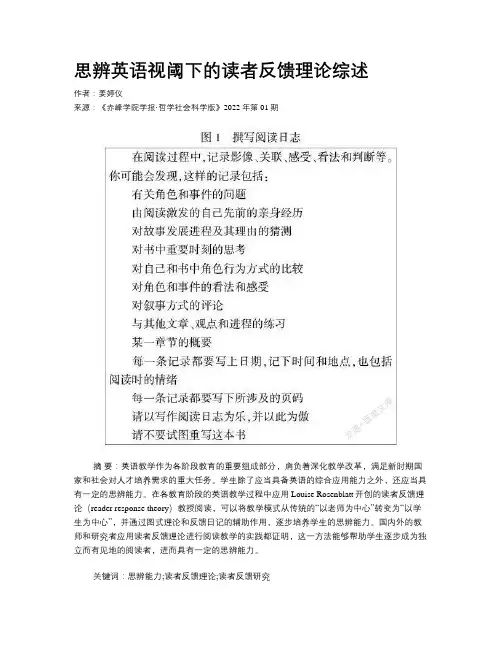
思辨英语视阈下的读者反馈理论综述作者:姜婷仪来源:《赤峰学院学报·哲学社会科学版》2022年第01期摘要:英语教学作为各阶段教育的重要组成部分,肩负着深化教学改革,满足新时期国家和社会对人才培养需求的重大任务。
学生除了应当具备英语的综合应用能力之外,还应当具有一定的思辨能力。
在各教育阶段的英语教学过程中应用Louise Rosenblatt开创的读者反馈理论(reader response theory)教授阅读,可以将教学模式从传统的“以老师为中心”转变为“以学生为中心”,并通过图式理论和反馈日记的辅助作用,逐步培养学生的思辨能力。
国内外的教师和研究者应用读者反馈理论进行阅读教学的实践都证明,这一方法能够帮助学生逐步成为独立而有见地的阅读者,进而具有一定的思辨能力。
关键词:思辨能力;读者反馈理论;读者反馈研究中图分类号:H319.3 文献标识码:A 文章编号:1673-2596(2022)01-0084-06一、英语教学现状过去的很多年,我国传统的教育体系使不少英语老师习惯于在阅读课上详细讲解作者和相关历史事件等背景知识,以及生词、语法规则和文章结构等对于学生应试至关重要的内容。
另一方面,受儒家教育的影响,很多孩子从小就形成了固有的思维模式,以规定的结构进行思考和写作,而不敢轻易表达自己的观点。
这种传统的以教师为中心的课堂里,师生间的互动较少,不能很好地激发学生对于文章的开阔的和有创造性的思考[1],学生思维能力的发展有可能会受到极大的牵制,从而阻碍他们成为独立的思考者。
近年来,随着全球化竞争的推进,很多国家都将思辨能力列入了各级教育的培养任务中。
“思辨”一词,最早语出《礼记·中庸》:“博学之,审问之,慎思之,明辨之,笃行之”。
“慎思”与“明辨”强调周密的思考和明晰的分辨,即基于对信息的分析,而并非信息的简单叠加。
培养思辨能力,就要求我们通过对事物或问题的分析、推理、评估,最终解决问题,或形成决策和结论。
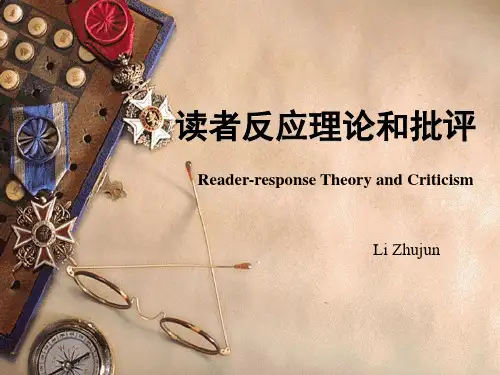
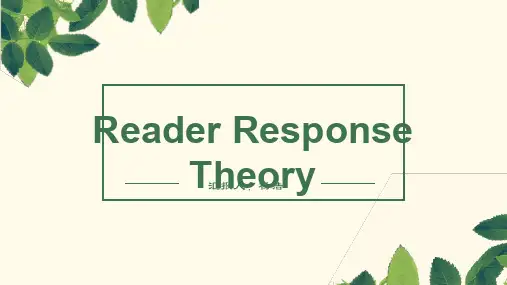
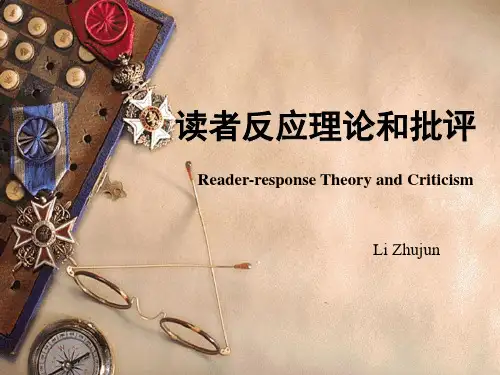
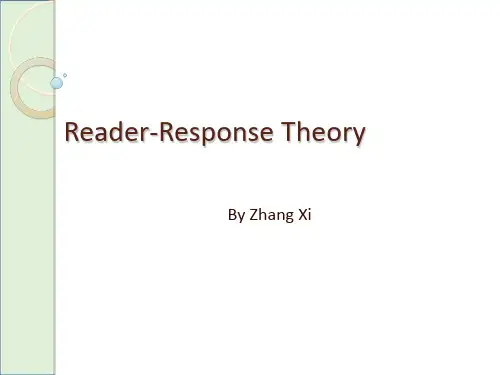
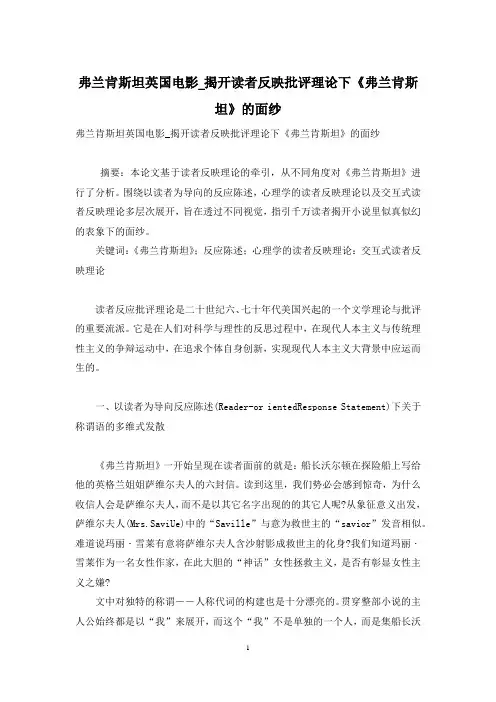
弗兰肯斯坦英国电影_揭开读者反映批评理论下《弗兰肯斯坦》的面纱弗兰肯斯坦英国电影_揭开读者反映批评理论下《弗兰肯斯坦》的面纱摘要:本论文基于读者反映理论的牵引,从不同角度对《弗兰肯斯坦》进行了分析。
围绕以读者为导向的反应陈述,心理学的读者反映理论以及交互式读者反映理论多层次展开,旨在透过不同视觉,指引千万读者揭开小说里似真似幻的表象下的面纱。
关键词:《弗兰肯斯坦》;反应陈述;心理学的读者反映理论:交互式读者反映理论读者反应批评理论是二十世纪六、七十年代美国兴起的一个文学理论与批评的重要流派。
它是在人们对科学与理性的反思过程中,在现代人本主义与传统理性主义的争辩运动中,在追求个体自身创新,实现现代人本主义大背景中应运而生的。
一、以读者为导向反应陈述(Reader-or ientedResponse Statement)下关于称谓语的多维式发散《弗兰肯斯坦》一开始呈现在读者面前的就是:船长沃尔顿在探险船上写给他的英格兰姐姐萨维尔夫人的六封信。
读到这里,我们势必会感到惊奇,为什么收信人会是萨维尔夫人,而不是以其它名字出现的的其它人呢?从象征意义出发,萨维尔夫人(Mrs.SaviUe)中的“Saville”与意为救世主的“savior”发音相似。
难道说玛丽・雪莱有意将萨维尔夫人含沙射影成救世主的化身?我们知道玛丽・雪莱作为一名女性作家,在此大胆的“神话”女性拯救主义,是否有彰显女性主义之嫌?文中对独特的称谓――人称代词的构建也是十分漂亮的。
贯穿整部小说的主人公始终都是以“我”来展开,而这个“我”不是单独的一个人,而是集船长沃尔顿、弗兰肯斯坦和怪物三人于一体。
在一般小说里头如此嵌套式的人称叙述实在不多见,这无疑是《弗兰肯斯坦》推陈出新的魅力闪光点之一。
同时,以“我”和“你”这种对话方式展开,既“活化”了文笔的僵硬,又进一步将读者拉近,直接秒杀了读者只是个“看戏人”此种僵硬的思维定式。
二、心理学的读者反映理论(Psycho log ical Reader-Response Theory)下的关于诠释定义的防御阶段的活现我们在阅读过程中,总是会把自己的身份主题加入文本之中,文学诠释中的防御阶段以其独特姿态影响着我们的心理过程。
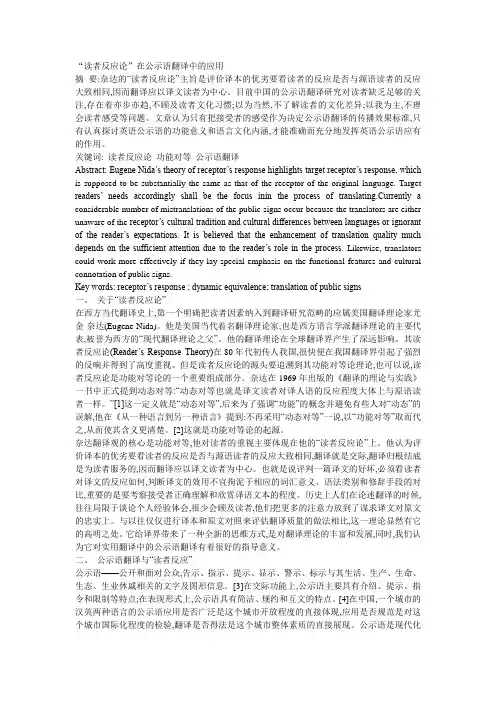
“读者反应论”在公示语翻译中的应用摘要:奈达的“读者反应论”主旨是评价译本的优劣要看读者的反应是否与源语读者的反应大致相同,因而翻译应以译文读者为中心。
目前中国的公示语翻译研究对读者缺乏足够的关注,存在着亦步亦趋,不顾及读者文化习惯;以为当然,不了解读者的文化差异;以我为主,不理会读者感受等问题。
文章认为只有把接受者的感受作为决定公示语翻译的传播效果标准,只有认真探讨英语公示语的功能意义和语言文化内涵,才能准确而充分地发挥英语公示语应有的作用。
关键词: 读者反应论功能对等公示语翻译Abstract: Eugene Nida’s theory of receptor’s response highlights target receptor’s response, which is supposed to be substantially the same as that of the receptor of the original language. Target readers’ needs accordingly shall be the focus inin the process of translating.Currently a considerable number of mistranslations of the public signs occur because the translators are either unaware of the receptor’s cultural tradition and cultural differences between languages or ignorant of the reader’s expectations. It is believed that the enhancement of translation quality much depends on the sufficient attention due to the reader’s role in the process. Likewise, translators could work more effectively if they lay special emphasis on the functional features and cultural connotation of public signs.Key words: receptor’s response ; dynamic equivalence; translation of public signs一、关于“读者反应论”在西方当代翻译史上,第一个明确把读者因素纳入到翻译研究范畴的应属美国翻译理论家尤金·奈达(Eugene Nida)。
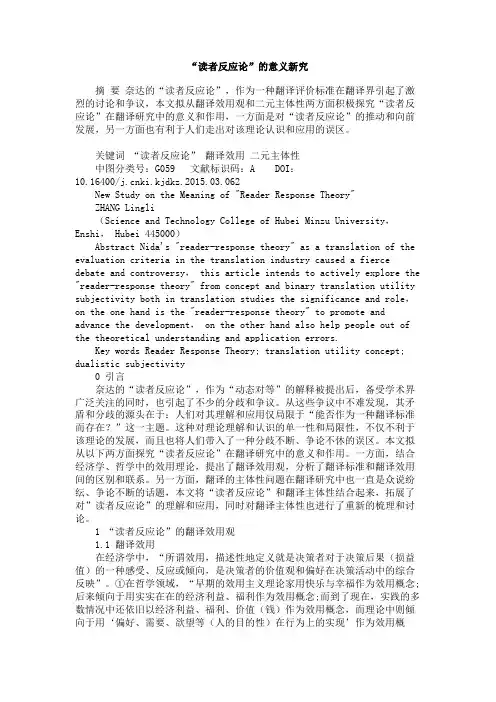
“读者反应论”的意义新究摘要奈达的“读者反应论”,作为一种翻译评价标准在翻译界引起了激烈的讨论和争议,本文拟从翻译效用观和二元主体性两方面积极探究“读者反应论”在翻译研究中的意义和作用,一方面是对“读者反应论”的推动和向前发展,另一方面也有利于人们走出对该理论认识和应用的误区。
关键词“读者反应论” 翻译效用二元主体性中图分类号:G059 文献标识码:A DOI:10.16400/ki.kjdkz.2015.03.062New Study on the Meaning of "Reader Response Theory"ZHANG Lingli(Science and Technology College of Hubei Minzu University,Enshi, Hubei 445000)Abstract Nida's "reader-response theory" as a translation of the evaluation criteria in the translation industry caused a fierce debate and controversy, this article intends to actively explore the "reader-response theory" from concept and binary translation utility subjectivity both in translation studies the significance and role,on the one hand is the "reader-response theory" to promote and advance the development, on the other hand also help people out of the theoretical understanding and application errors.Key words Reader Response Theory; translation utility concept; dualistic subjectivity0 引言奈达的“读者反应论”,作为“动态对等”的解释被提出后,备受学术界广泛关注的同时,也引起了不少的分歧和争议。
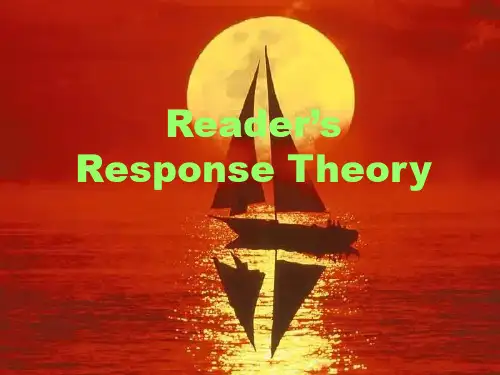
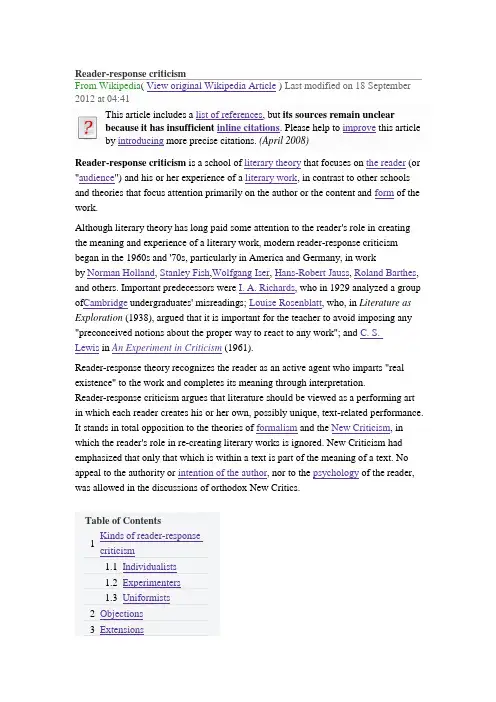
Reader-response criticismFrom Wikipedia ( View original Wikipedia Article ) Last modified on 18 September2012 at 04:41 This article includes a list of references , but its sources remain unclearbecause it has insufficient inline citations . Please help to improve this article by introducing more precise citations. (April 2008) Reader-response criticism is a school of literary theory that focuses on the reader (or "audience ") and his or her experience of a literary work , in contrast to other schools and theories that focus attention primarily on the author or the content and form of the work. Although literary theory has long paid some attention to the reader's role in creating the meaning and experience of a literary work, modern reader-response criticism began in the 1960s and '70s, particularly in America and Germany, in work by Norman Holland , Stanley Fish ,Wolfgang Iser , Hans-Robert Jauss , Roland Barthes , and others. Important predecessors were I. A. Richards , who in 1929 analyzed a group of Cambridge undergraduates' misreadings; Louise Rosenblatt , who, in Literature as Exploration (1938), argued that it is important for the teacher to avoid imposing any "preconceived notions about the proper way to react to any work"; and C. S. Lewis in An Experiment in Criticism (1961).Reader-response theory recognizes the reader as an active agent who imparts "real existence" to the work and completes its meaning through interpretation.Reader-response criticism argues that literature should be viewed as a performing art in which each reader creates his or her own, possibly unique, text-related performance. It stands in total opposition to the theories of formalism and the New Criticism , in which the reader's role in re-creating literary works is ignored. New Criticism had emphasized that only that which is within a text is part of the meaning of a text. No appeal to the authority or intention of the author , nor to the psychology of the reader, was allowed in the discussions of orthodox New Critics.4 Notes and references5 Further reading6 External linksKinds of reader-response criticismOne can sort reader-response theorists into three groups: those who focus upon the individual reader's experience ("individualists"); those whoconduct psychological experiments on a defined set of readers ("experimenters"); and those who assume a fairly uniform response by all readers ("uniformists"). One can therefore draw a distinction between reader-response theorists who see the individual reader driving the whole experience and others who think of literary experience as largely text-driven and uniform (with individual variations that can be ignored). The former theorists, who think the reader controls, derive what is common in a literary experience from shared techniques for reading and interpreting which are, however, individually applied by different readers. The latter, who put the text in control, derive commonalities of response, obviously, from the literary work itself. The most fundamental difference among reader-response critics is probably, then, between those who regard individual differences among readers' responses as important and those who try to get around them.IndividualistsIn the 1960s, David Bleich began collecting statements by influencing students of their feelings and associations.[clarification needed] He used these to theorize about the reading process and to refocus the classroom teaching of literature. He claimed that his classes "generated" knowledge, that is, knowledge of how particular persons recreate texts.Michael Steig and Walter Slatoff have, like Bleich, shown that students' highly personal responses can provide the basis for critical analyses in the classroom. Jeffrey Berman has encouraged students responding to texts to write anonymously and share with their classmates writings in response to literary works about sensitive subjects like drugs, suicidal thoughts, death in the family, parental abuse and the like. A kind of catharsis bordering on therapy results. In general, American reader-response critics have focused on individual readers' responses. American magazines like Reading Research Quarterly and others publish articles applying reader-response theory to the teaching of literature.In 1961, C. S. Lewis published An Experiment in Criticism, in which he analyzed readers' role in selecting literature. He analyzed their selections in light of their goals in reading.In 1967, Stanley Fish published Surprised by Sin, the first study of a large literary work (Paradise Lost) that focused on its readers' experience. In an appendix, "Literature in the Reader", Fish used "the" reader to examine responses to complex sentences sequentially, word-by-word. Since 1976, however, he has turned to real differences among real readers. He explores the reading tactics endorsed by different critical schools, by the literary professoriate, and by the legal profession, introducing the idea of "interpretive communities" that share particular modes of reading.In 1968, Norman Holland drew on psychoanalytic psychology in The Dynamics of Literary Response to model the literary work. Each reader introjects a fantasy "in" the text, then modifies it by defense mechanisms into an interpretation. In 1973, however, having recorded responses from real readers, Holland found variations too great to fit this model in which responses are mostly alike but show minor individual variations.Holland then developed a second model based on his case studies 5 Readers Reading. An individual has (in the brain) a core identity theme (behaviors then becoming understandable as a theme and variations as in music). This core gives that ind ividual a certain style of being—and reading. Each reader uses the physical literary work plus invariable codes (such as the shapes of letters) plus variable canons (different "interpretive communities", for example) plus an individual style of reading to build a response both like and unlike other readers' responses. Holland worked with others at the State University of New York at Buffalo, Murray Schwartz, David Willbern,and Robert Rogers, to develop a particular teaching format, the "Delphi seminar," designed to get students to "know themselves".ExperimentersReuven Tsur in Israel has developed in great detail models for the expressivityof poetic rhythms, of metaphor, and of word-sound in poetry(including different actors' readings of a single line of Shakespeare). Richard Gerrig in the U.S. has experimented with the reader's state of mind during and after a literary experience. He has shown how readers put aside ordinary knowledge and values while they read, treating, for example, criminals as heroes. He has also investigated how readers accept, while reading, improbable or fantastic things (Coleridge's "willing suspension of disbelief"), but discard them after they have finished.In Canada, David Miall, usually working with Donald Kuiken, has produced a large body of work exploring emotional or "affective" responses to literature, drawing on such concepts from ordinary criticism as "defamiliarization" or "foregrounding". They have used both experiments and new developments in neuropsychology, and have developed a questionnaire for measuring different aspects of a reader's response.There are many other experimental psychologists around the world exploring readers' responses, conducting many detailed experiments. One can research their work through their professional organizations, the International Society for the Empirical Study of Literature and Media, and International Association of Empirical Aesthetics, and through such psychological indices as PSYCINFO.Two notable researchers are Dolf Zillmann and Peter Vorderer, both working in the field of communications and media psychology. Both have theorized and tested ideas about what produces emotions such as suspense, curiosity, surprise in readers, the necessary factors involved, and the role the reader plays. Jenefer Robinson, a researcher in emotion, has recently blended her studies on emotion with its role in literature, music, and art.UniformistsWolfgang Iser exemplifies the German tendency to theorize the reader and so posit a uniform response. For him, a literary work is not an object in itself but an effect to be explained. But he asserts this response is controlled by the text. For the "real" reader, he substitutes an implied reader, who is the reader a given literary work requires. Within various polarities created by the text, this "implied" reader makes expectations, meanings, and the unstated details of characters and settings through a "wandering viewpoint". In his model, the text controls. The reader's activities are confined within limits set by the literary work.Another important German reader-response critic was Hans-Robert Jauss, who defined literature as a dialectic process of production and reception (Rezeption--the term common in Germany for "response"). For Jauss, readers have a certain mental set, a "horizon" of expectations (Erwartungshorizont), from which perspective each reader, at any given time in history, reads. Reader-response criticism establishes these horizons of expectation by reading literary works of the period in question.Both Iser and Jauss, and the Constance School they exemplify, return reader-response criticism to a study of the text by defining readers in terms of the text. In the same way, Gerald Prince posits a "narratee", Michael Riffaterre posits a "superreader",and Stanley Fish an "informed reader." And many text-oriented critics simply speakof "the" reader who typifies all readers...ObjectionsReader-response critics hold that in order to understand a text, one must look to the processes readers use to create meaning and experience. Traditional text-oriented schools, such as formalism (literature), often think of reader-response criticism asan anarchicsubjectivism, allowing readers to interpret a text any way they want.Text-oriented critics claim that one can understand a text while remaining immune to one's own culture, status, personality, and so on, and hence "objectively."To reader-response based theorists, however, reading is alwaysboth subjective and objective. Some reader-response critics (uniformists) assume abi-active model of reading: the literary work controls part of the response and the reader controls part. Others, who see that position as internally contradictory, claim that the reader controls the whole transaction (individualists). In such a reader-active model, readers and audiences use amateur or professional procedures for reading (shared by many others) as well as their personal issues and values.Another objection to reader-response criticism is that it fails to account for the text being able to expand the reader's understanding. While readers can and do put their own ideas and experiences into a work, they are at the same time gaining new understanding through the text. This is something that is generally overlooked in reader-response criticism.Some argue that 'artworks' are now purposely being fabricated which lack meaning but rather the 'artworks' are fabricated only to generate a reader response. The reader response then is corralled via interpretative communities. Reader response rather than handing a freedom to the reader empowers the leaders of an interpretative community against the reader. The reader has no ground to evaluate the 'artwork' as the artwork is senseless. Only a reader response, basically an emotive response, is legitimate. The Web provides an ideal way to form such interpretative communities. The power of reader response strategy is that people are fundamentally 'hungry' for culture and will attempt to impart meaning even to artworks that are senseless. Of course, people can always opt out of these interpretative communities centered around senseless artworks with little to no loss via-a-vis culture and almost certainly a cultural gain. ExtensionsReader-response criticism relates to psychology, both experimental psychology for those attempting to find principles of response, and psychoanalytic psychology for those studying individual responses. Post-behaviorist psychologists of reading andof perception support the idea that it is the reader who makes meaning. Increasingly, cognitive psychology, psycholinguistics, neuroscience,and neuropsychoanalysis have given reader-response critics powerful and detailed models for the aesthetic process. In 2011 researchers found that during listening to emotionally intense parts of a story, readers respond with changes in heart rate variability, indicative of increased activation of the sympathetic nervous system. Intense parts of a story were also accompanied by increased brain activity in anetwork of regions known to be involved in the processing of fear,including amygdala.[1]Because it rests on psychological principles, a reader-response approach readily generalizes to other arts: cinema (David Bordwell), music, or visual art (E. H. Gombrich), and even to history (Hayden White). In stressing the activity of the scholar, reader-response theory justifies such upsettings of traditional interpretations as, for example, deconstruction or cultural criticism.Since reader-response critics focus on the strategies readers are taught to use, they address the teaching of reading and literature. Also, because reader-response criticism stresses the activity of the reader, reader-response critics readily share the concernsof feminist critics and critics writing on behalf of gays, ethnic minorities, orpost-colonial peoples.Oxford Dictionary of Literary Terms:reader-response criticismTopHome > Library > Literature & Language > Literary Dictionaryreader‐response criticism, a general term for those kinds of modern criticism and literary theory that focus on the responses of readers to literary works, rather than on the works themselves considered ass elf‐contained entities. It is not a single agreed theory so much as a shared concern with a set of problems involving the extent and nature of readers' contribution to the meanings of literary works, approached from various positions including those of structuralism (see competence), psychoanalysis, phenomenology, and hermeneutics. The common factor is a shift from the description of texts in terms of their inherent properties to a discussion of the production of meanings within the reading process. Important contributions to this debate include Wolfgang Iser's The Act of Reading(1978), which sees readers as ‘actualizing’ texts by filling in their ‘gaps’ or indeterminacies of meaning, and Stanley Fish's Is There a Text in this Class? (1980), which gives the reader an even more active role as the text's true producer. A somewhat distinct line of historical investigation is represented by the reception theory of Hans Robert Jauss. For a fuller account, consult Elizabeth Freund, The Return of the Reader (1987).Read more: /topic/reader-response-criticism#ixzz2BKjP9UhT。
读者反应理论
读者反应理论(Reader-Response Theory),是二十世纪七十年代末起流行起来的一种书面文本解读理论,它强调个体读者读者在阅读过程中受自身背景,思想观念,文化心理等影响,对文本产生不同的思考、体验,从而对读者的阅读产生不同的反应。
读者反应理论的出现,有利于建立和认识读者,更加重视读者的地位和现实意义。
读者反应理论并不是单一的理论,它包括整体反应理论,结构反应理论,文化反应理论,文本反应理论等多种学理,给文本解读和文本翻译方面提出了很多更新的解决方法。
在高等教育行业,读者反应理论可以有效地推动教学质量的改善,解决各类课题,提升师生的思考能力、临场反应能力。
学校可以采取多种措施,针对一般课程的教学同时给学生提供多元化的学科学习方法,激发学生的思考热情,加强对不同思维方式的讨论,并根据学生的背景、思想观念等,设计出更加让学生产生共鸣的教学模式,从而让学生能够更加实用地理解教学内容,拓展个人的思维深度和思考宽度,进而使整个教育体系的素质得到提升。
总之,读者反应理论是一种时代性的理论,它对于文本释义和文本翻译方面产生了革命性影响,在高等教学行业也发挥了重要作用,推动着教育体系持续改善着不断发展。
语用学视域下的交互读者反应批评理论作者:王传伟来源:《北方文学》2019年第15期摘要:语用学是美国符号学家莫里斯在20世纪30年代末提出关于符号三分法中的一支,是用来阐释符号与使用者之间的关系。
而读者反应批评理论最早出现于20世纪20年代,其探讨的是文本与读者之间的关系。
本文试图通过符号学中的语用学去探讨文学中的交互读者反应批评理论及文本意义的不确定。
关键词:语用学;读者反应批评理论;不确定性一、引语作为现代语言符号的奠基人,莫里斯的主要贡献就是把符号划分出语构、语义和语用三个维度,把符号学划分为相应的三个分支——语构学、语义学和语用学。
其中,语构学关注“符号彼此间的形式关系”,语义学关注“符号对其所适用的对象的关系”,语用学关注“符号对解释者的关系”。
(王铭玉2013:59)文学文本作为一种典型的美学符号,对其的分析与阐释是必然的。
从符号学角度分析艺术符号构成了美学符号学的主要任务。
按照莫里斯符号学的观点,如果从符号的语构(语形)、语义、语用要素及其相互关系分析一个符号,则该符号可以得到全面的分析,由此相应产生符号学的三个组成学科。
同样道理,对于艺术符号的分析也可以从这三个角度进行。
但是,在本篇论文中我们仅仅从语用学角度去探讨语用学与读者反应批评理论的关系。
20世纪40年代,美国新批评家威廉·维姆萨特(William K.Wimsatt)和蒙罗·伯尔兹利(Monroe C.Beardsley)发表了两篇颇具影响的论文——《意图谬论》和《情感谬误》,标志着文学批评转向以文本为中心。
20世纪60年代起,随着解释学与接受美学的兴起,文学批评开始从文本转向读者,读者反应批评由此兴起。
简而言之,文学批评理论更加关注符号(文字)与接受者(读者)之间的关系。
上文已提及语用学是关注“符号对解释者的关系”,关于它具体的适用范围,也就是说使用者在什么样的条件下运用它,会得到何种意义。
符号学家里奇指出,凡是应对了以下四条中的一条即可:1.是否考虑到发送者与接收者?2.是否考虑发送者的意图,与接受者的解释?3.是否考虑符号的语境?4.是否考虑使用符号而施行行为?“这实际上就是说,一旦牵涉符号使用者,就成了符用学问题。
读者反应批评理论述评史霞【期刊名称】《海外英语(上)》【年(卷),期】2015(000)008【摘要】读者反应批评理论作为后现代主义的阅读理论的代表成为国内学者探讨的热点.这种建立在美学、解构主义和精神分析学等相关领域或学科基础之上的批评理论在其价值取向、知识观、中心观、意义观和模式观等诸多方面明显别与其他阅读理论.通过对其探讨以促其进一步的发展,更好服务于国内阅读教学.%Recently, reader-response criticism theory as a representative of post-modernism reading theory has been a hot spot to be explored by the scholars at home. The paper gives a brief introduction to Reader-response criticism theory, and then explores its value orientation, views on knowledge and its centre,the text and meaning and reading mode to promote its further development and give service to reading learning.【总页数】2页(P206-207)【作者】史霞【作者单位】黔东南民族职业技术学院临床医学系,贵州凯里 556000【正文语种】中文【中图分类】H0【相关文献】1.文学批评理论与英美文学教学的新思路--以"新批评"和"读者反应批评"理论为例[J], 文培红2.读者反应批评——文学翻译批评新视角 [J], 杨平3.读者反应批评反新批评"感受谬见"说之声——从斯坦利·费什的观点出发 [J], 樊碧雪4.读者反应批评理论述评 [J], 史霞5.从批评史看读者反应批评与新批评的“对立” [J], 简.汤普金斯;刘峰因版权原因,仅展示原文概要,查看原文内容请购买。